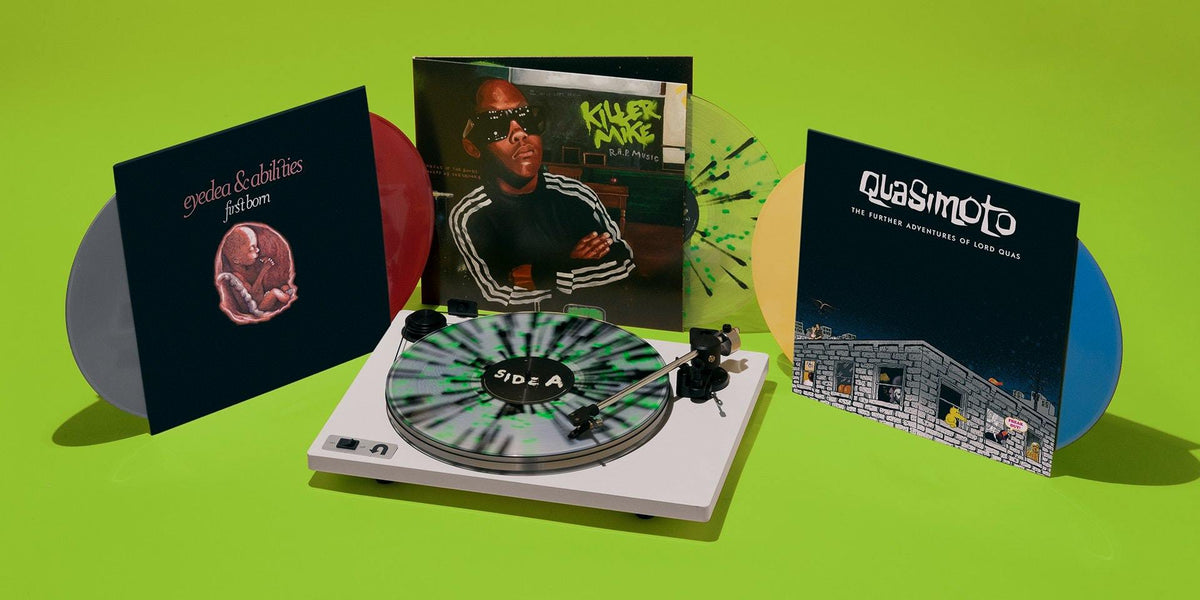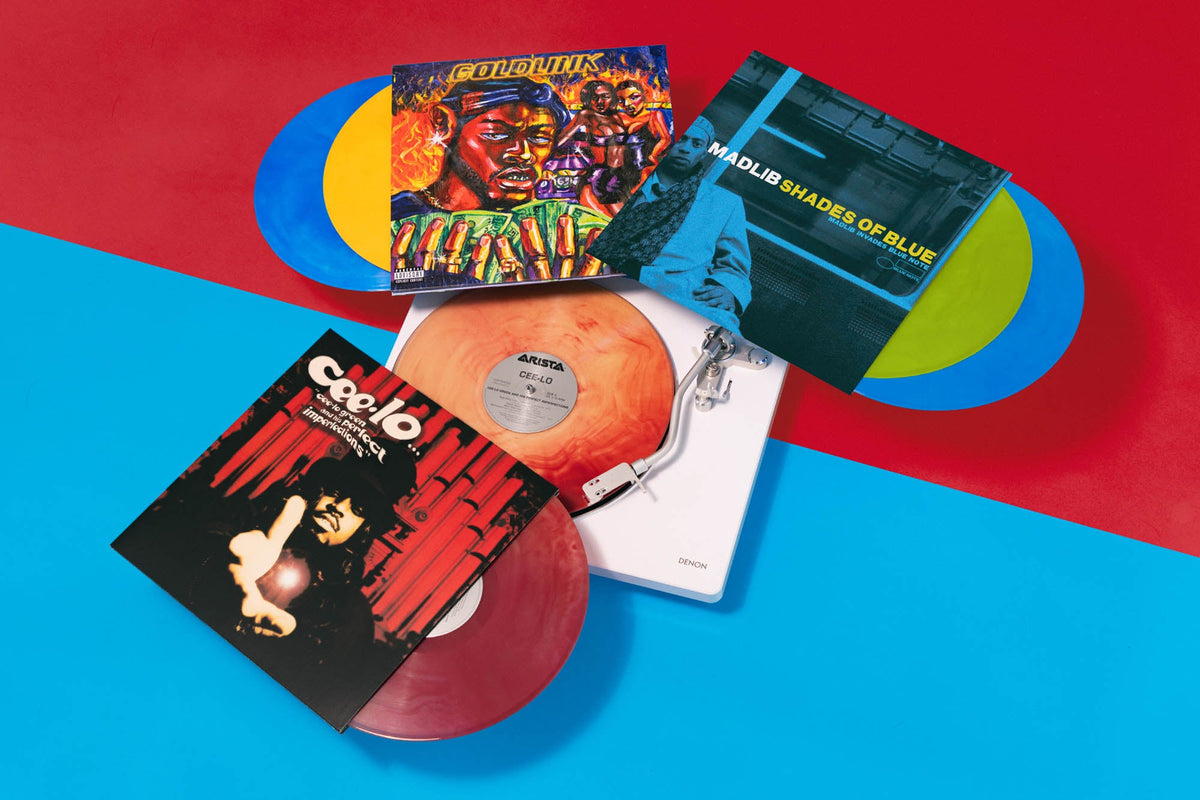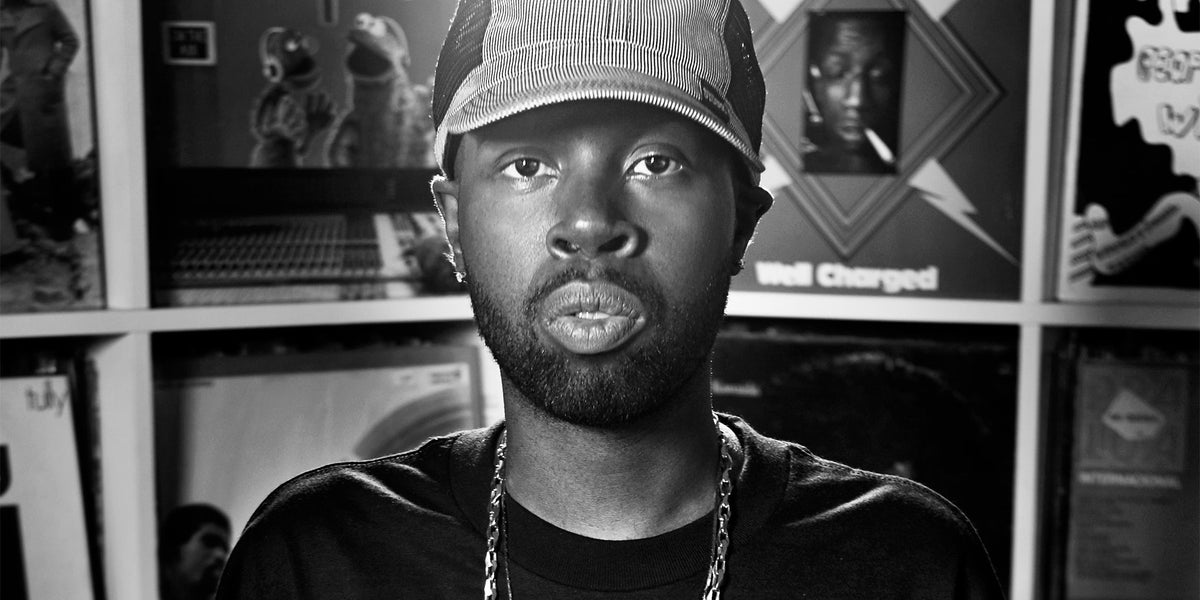Madlib’s Incomparable ‘Shades of Blue’
On the legendary producer’s Blue Note passion project
During a television interview sometime in the 1960s, jazz composer Duke Ellington admitted that he was over the idea of genre. By this time, Ellington’s career had lasted well into his 60s — he’d released dozens of albums, composed thousands of songs and led bands on stages in every corner of the globe. But in this particular moment, sitting in a leather chair with his fist to his chin, he posited that Black influence on American music was omnipresent, undeniable. And not just limited to jazz or rhythm and blues or soul or gospel, but to all music. “I think the music situation today has reached the point where it isn’t necessary for categories,” he admitted. “I think that what people hear in music is either agreeable to the ear or not. You can take, probably, the most trite of all the things people are complaining about; and you give it to one of the great artists … and you’d probably get a gem of a performance.”
It makes complete sense for a jazz pioneer — and one of the greatest musicians of the 20th century — to feel that way after 40-plus years of experience. But it’s surreal to think that this conversation happening nearly a decade before the birth of hip-hop would change the way people create and experience music. How would Duke Ellington have reacted to the art of sampling? What would’ve gone through his mind when he first heard his repurposed piano keys gracing Ghostface Killah’s “Malcolm” or the late Mac Miller’s “Diablo”? Would he see jazz and rap music as kindred spirits, as so many of his musical progeny have?
One of those musical offspring would be the producer Madlib, who the California rapper Blu called “the Duke Ellington of hip-hop” in 2015. Born Otis Jackson Jr. in Oxnard, California, in 1973, the course of his life would be dictated by music. Both of Jackson’s parents were musicians — his mother, Dora Sinesca Faddis-Jackson, was a songwriter and pianist who also wrote songs for Madlib’s father, the soul singer, bandleader and multi-instrumentalist Otis Jackson Sr. His uncle, trumpeter Jon Faddis, contributed to sessions for artists from Kool & The Gang to Luther Vandross and, you guessed it, Duke Ellington. “Growing up, my brother and I were in the lab the whole time. And our father was real strict about us not clowning around when it came to music,” Madlib’s brother Michael Jackson — who raps and produces under the name Oh No — told Wax Poetics in 2007. Otis Jr. was so into the music he was hearing that when he didn’t have access to a record player, he would run pen tips along the grooves of records to get even the faintest hint of sound.
The Jackson boys got a taste of the musician life early. Funk, soul and jazz were everywhere at home, with artists constantly shuffling in and out of their father’s studio. Trumpeter Dizzy Gillespie once showed up to their house for gumbo. Otis grew fond of these older artists and his father’s massive record collection, but rap was what first inspired him to make music for real. “Rapper’s Delight” by The Sugarhill Gang and early songs by dirty mack savant Too $hort were his first exposure, but it wasn’t until he heard the music of DJ Marley Marl that he knew producing was his calling. “I was into the producers before the rappers,” he told Wax Poetics. “Them hard drums Marley Marl used. That’s when I first said ‘I wanna do that.’” Sampling came into Otis’ life when he was 11 years old; he would borrow friend DJ Romes’ Casio keyboard to make his first beat tapes. Any free time Otis had was spent on music, digging through crates of records, listening to them and chopping beats. It wasn’t long before he established a tireless work ethic and, by the early 1990s, had dubbed his studio the Crate Diggas Palace.
The beats Otis, now calling himself Madlib, was making at the Palace combined drum breaks with weirder flourishes. Scuzzy basslines clashed with ghostly horns; vocal clips from vintage blaxploitation movies would play out with extra reverb and distortion. As Madlib, Otis was making sun-bleached boom-bap that was the inverse of work by East Coast producers like Wu-Tang Clan’s RZA, grimy but warped like the records had been left out in the California heat. These beats, many created on the SP-1200 sampler, became the foundation of Crate Diggas Palace, which also became a crew name and a record label of its own. Like any aspiring musician with access to a studio, he cut demos with friends, his brother Oh No and rappers Medaphoar, Dudley Perkins and Kankick under the name CDP. But his first professional release came as a member of a smaller group called the Lootpack, alongside rapper Wildchild and DJ Romes. The trio had landed two features on California group Tha Alkaholiks’ 1993 debut album 21 & Over, and the boost of confidence led them to release an EP of their own, Psyche Move, via the Crate Diggas Palace label founded by Otis Sr.
Madlib’s smoky production with Lootpack eventually caught the attention of Christopher “Peanut Butter Wolf” Manak, founder and owner of independent label Stones Throw Records. Lootpack would release their debut album Soundpieces: Da Antidote! through Stones Throw in 1999, followed by Madlib’s solo debut The Unseen — credited to Quasimoto, the high-pitched alter ego first introduced on the Da Antidote track “Answers” — in 2000. The production on The Unseen dug even further into the jazz and vintage film haze that Madlib had been furnishing since the early ’90s. Samples from filmmaker Melvin Van Peebles and assorted jazz artists permeate nearly every song; from flutist James Moody (“MHBs”) and saxophonist Maceo Parker (“Discipline 99 Pt. 1”), to space-minded composer Sun Ra (“Astro Black.”)
Madlib wasn’t unique for sampling these artists — the so-called “jazz rap” movement already had a chokehold on the East and West Coasts by this point — but his methods embraced the psychedelic and dreamy. The Unseen was created during a month-long mushroom binge, which no doubt amplified the music’s hazy atmosphere and gave Madlib the confidence to build an album around the “pig-faced Alf nigga” character who would serve as his co-conspirator.
For all its weirdness, The Unseen garnered critical acclaim and was a modest success for Stones Throw. But instead of a proper follow-up, Madlib fell further into jazz. During the summer of 2000, he created his own jazz ensemble in Stones Throw’s headquarters. Heavy emphasis on “created,” since all its non-Madlib members — Joe McDuphrey, Malik Flavors, Ahmad Miller and Monk Hughes — were fake, more personae for him to hide behind. The “ensemble,” called Yesterdays New Quintet, was really a combination of sampler, drum machine and live instruments that Madlib arranged to sound like a full band. Stones Throw released the group’s loose and meandering 67-minute debut album Angles Without Edges on September 11, 2001; overshadowed, like everything else, by the World Trade Center plane bombings in New York City.
Though the album made virtually no impact on the charts or the streets, Peanut Butter Wolf was still willing to indulge whatever flights of fancy Madlib wanted to explore. He enjoyed Angles but was searching for a way to reconnect Madlib’s fascination with jazz back to his roots in rap. During a phone call with a representative from esteemed jazz label Blue Note Records, who was a big fan of Yesterdays New Quintet, Wolf joked that the label should give Madlib access to their record archives in the future. To his shock, the label was thrilled with the idea. Madlib, one of rap’s most voracious jazz heads and a vinyl collector who once claimed to own four tons of records, was given free rein over Blue Note’s entire physical backlog to cover and rearrange as he saw fit. This was the beginning of Shades of Blue: Madlib Invades Blue Note.
The invasion part of the subtitle initially seems strange, considering how excited Blue Note was to have Madlib remix several of their classic records, but it served more purpose than just edgy marketing. Rappers and producers had worked with jazz artists in the past — A Tribe Called Quest and De La Soul had recruited bassist Ron Carter and saxophonist Maceo Parker, respectively, to contribute to their albums; Guru of the duo Gang Starr took it a step further by creating Jazzmatazz, a series of albums where he rhymed over live arrangements from Branford Marsalis, Donald Byrd and Roy Ayers, among others. Conversely, Shades of Blue is an album that both embraces and bucks tradition. Even though it’s known as a remix album, Madlib’s work came from recontextualizing personal favorites through sampling and live-band interpolation. Sometimes, he’d change the drum pattern on a song or just add new ones. Other times, he would add flourishes from cohorts like the Morgan Adams Quartet Plus Two — yet another fake band for Madlib to add to his jazzy extended universe. And with no sample clearance issues looming over his head, Madlib had unprecedented control over how deep the remixes could go.
Take opening track “Slim’s Return,” which turns chopped samples from Gene Harris & The Three Sounds’ song “Book of Slim” into a thumping groove. All the instruments have more presence in the mix, with the shuffle of the percussion, bass licks and hits of glockenspiel blending smoothly with Madlib’s disc scratches. It sounds like a natural evolution of the sound he’d been building with Lootpack and Quasimoto, but it also acts as a sleight of hand for the rest of the project.
“Slim’s Return” is immediately followed by “Distant Land,” which is a remix of the Donald Byrd song of the same name. Byrd’s version features softer percussion and xylophone notes dotting its outer regions. On his remix, Madlib ups the tempo, adds sampled tambourine from Cresa Watson’s “Dead” and more forceful drums, swaps out the xylophone for soft piano keys and adds a horn line that drags smoothly through the foundation like a rake through the mud. And for a final touch, sampled vocals from the late Harlem rapper Big L’s song “Flamboyant” roam through the instrumental corridors. Byrd’s original melody and structure are shaken up by the new percussion, which abandons the tampered march of the original for a syncopated shuffle that lands like a breakbeat. “Distant Land” is Shades of Blue’s first instance of musical alchemy, the rebel spirits of hip-hop and jazz folding into each other until one is indistinguishable from the other.
Synthesis is the recurring theme of Shades of Blue, and Madlib, over a decade into his production career, offers himself as the conduit. As much as the album is about the relationship between jazz and rap, there’s a fair smattering of the funk he grew up on throughout most of these songs as well. He takes the simmering sounds of Ronnie Foster’s “Mystic Brew,” adds handclaps and sampled voice murmurs, and gives the song’s iconic baseline — itself fodder for sampling, most notably in A Tribe Called Quest’s “Electric Relaxation” — a funky facelift on his recreation, here called “Mystic Bounce.” “Montara” does the same for the Bobby Hutcherson standard, recreating the original’s clarinet and xylophone melody with flute before transitioning into a breakdown with hi-hats and synthetic crunch. On his rendition of Bobbi Humphrey’s “Please Set Me At Ease,” Madlib swaps out the former’s mellow pianos and flutes for guitar drenched in wah-wah pedal and a swirl of piano stabs, bass synth and clanging percussion. His old friend Medaphoar, now going by M.E.D., joins in on the fun, providing the album’s sole guest rap verse.
Every one of these songs pulses with movement and meaning, but the album’s most interesting moments come closer to the middle and end. “Funky Blue Note,” the project’s only original composition, is a maelstrom of instruments and sampled playing from Madlib and his imaginary Morgan Adams Quartet Plus Two outfit, meant to pay tribute to the Blue Note of the 1960s and ’70s. “That’s the sound I like from Blue Note,” he explained in an album press release. “You were just free to do whatever ideas you wanted to do.” The organized chaos of “Funky Blue Note” clashes with the relaxed slink of his cover of Horace Silver Quintet’s “Song For My Father,” which is a personal favorite of Madlib’s and, along with the boisterous remix of “Stepping Into Tomorrow,” is among the album’s most reverent pieces. It’s often difficult to tell where the samples end and the interpolations begin, and Madlib’s embrace of more aliases like Sound Directions only complicates things further. All the extra work and confusion are a part of Madlib’s vision. He wasn’t set on just recreating or remixing these songs — he intertwined his DNA with that of Blue Note, imprinting himself and all his personae into their musical universe forever.
That sense of transformation was felt by many Blue Note alumni. Several songs begin or end with spoken interludes from jazz greats, like saxophonist Lou Donaldson (“Slim’s Return”), guitarist Melvin Sparks and organists Reuben Wilson (“Mystic Bounce”) and Leon Spencer (“Montara”). R&B singer Dwele beams in at the end of “Song For My Father,” as well as rap producer Steinski at the end of “Please Set Me At Ease.”
But the most notable interlude comes from the late MF DOOM, who speaks over the hazy sample of Bobbi Humphrey’s “Blacks and Blues” that leads into “Stepping Into Tomorrow.” Shades of Blue was released a full year before Madlib and DOOM’s legendary team-up Madvillainy would hit stores, but since the original version of the album leaked online beforehand, DOOM’s brief appearance was a sly wink to the privy internet crate diggers who already knew of the duo’s partnership: “I have no prior knowledge to any invasion or any invasion being planned or executed. And I have no ties to Madlib or any organizations affiliated. Thank you.” In a way, the message from DOOM — who Madlib once compared to jazz saxophonist Charlie Parker — embodies the tongue-in-cheek but dead serious ethos of Shades of Blue as a whole. Though Yesterdays New Quintet isn’t credited on the album, the fake crew’s conception had been the fuel for Madlib to properly realize his jazz-rap dreams.
After its release, Shades of Blue did find an audience of rap fans and jazz heads astounded by Madlib’s dexterity as a producer. In 2014, just over a decade after its release, he told Spin that it’s “the album I’m most proud of actually out of everything.” By 2019, Madlib had accrued so many samples and recordings of his own that the electronic producer Kieran “Four Tet” Hebden turned the Shades process against him, creating the 2021 compilation Sound Ancestors. Its legacy is often trounced by his work with DOOM, Indiana firestarter Freddie Gibbs, and even his old Quasimoto work, but Shades remains the closest thing to a passion project Madlib has in his entire discography. For a rap producer who grew up under the pull of jazz, Shades is the ultimate full-circle moment.
Dylan “CineMasai” Green is a rap and film journalist, a contributing editor at Pitchfork and the host of the Reel Notes podcast. His work has appeared in Okayplayer, Red Bull, DJBooth, Audiomack, The Face, Complex, The FADER and the dusty tombs of Facebook Notes. He's probably in a Wawa mumbling a BabyTron verse to himself.
Related Articles
Join the Club!
Join Now, Starting at $36Pages







